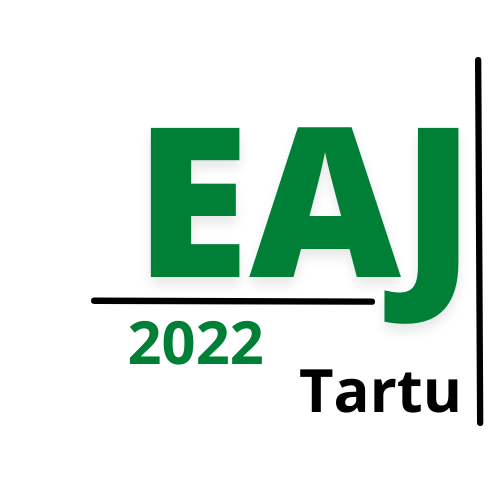
European Actuarial Journal Conference 2022 Tartu, Estonia
Keynote Speakers

Annamaria Olivieri is Professor of Mathematical Methods for Economics, Actuarial Science and Finance at the Department of Economics and Management of University of Parma (Italy). She is an Associate Investigator of CEPAR, UNSW (Sydney). She is Associate Editor of the European Actuarial Journal and editorial board member of Risks. Her research interests include life and health insurance modelling and actuarial risk management. Her work has been published (among the others) in Insurance: Mathematics and Economics, Astin Bulletin, Annals of Actuarial Science, European Actuarial Journal, Risks.
Topic of presentation: FLEXIBILITY IN ANNUITY BENEFITS IN VIEW OF MORTALITY/LONGEVITY UNCERTANTY AND INDIVIDUALS’ LONGEVITY RISK APPETITE (OR UNAWARENESS)
Despite the growing need for individuals to protect their assets from the longevity risk to which they will be exposed after retirement, the demand for products offering longevity guarantees, namely annuities, remains low. Possible reasons include the cost of guarantees, but also the rigidity of the traditional annuity design, which implies an irreversible decision at issue. This contrasts with the attitude of individuals who, because of their risk appetite or unawareness, seem to prefer to postpone final decisions in this regard. This way, they show a willingness to retain their longevity risk up to some (high) age. On the other hand, traditional annuity designs expose the provider to the aggregate longevity risk.
Flexibility in the annuity design could, at least partially, reconcile the different needs of individuals and providers. Flexibility can be introduced in different ways. We address two solutions. First, the guarantees can be relaxed, and the related costs can be reduced, by allowing the benefit amount to fluctuate (up or down) according to a given mortality/longevity experience. Second, instead of an upfront loading at issue, periodic fees could be adopted, as they are more suitable to support a revision of the arrangement after issue. While the literature includes already several contributions on mortality/longevity-linked benefits, a pricing structure based on periodic fees has received little attention so far. We develop a discussion in this respect, considering mortality/longevity-linked annuities.

Martin Eling is Director of the Institute of Insurance Economics and Professor for Insurance Management at the University of St. Gallen. He is doing empirical research in the intersection of insurance business, economics, and mathematics. His research interests include a broad range of topics including strategic management, financial management, risk management, and asset management. The current agenda includes new research topics such as cyber risk, microinsurance, and long-term care. His research has been awarded by several leading institutions including the American Risk and Insurance Association (ARIA), the Casualty Actuarial Society (CAS), and the National Association of Insurance Commissioners (NAIC). Moreover, he had visiting positions at the University of Torino and Urbino (both in Italy). He is also board member of Concordia, one of Switzerland’s largest health insurance companies.
Topic of presentation: IS CYBER RISK INSURABLE?
We use data on cyber losses and model the potential market equilibrium for cyber insurance to document a market failure when portfolios of cyber risk are constructed. This can be explained by the distinct properties of cyber risk, namely heavy tails, strong (tail) dependencies, high costs due to asymmetric information, and modelling risk. Our results help to explain why many insurance companies are reluctant to offer cyber insurance on a broad scale. We also discuss ways to overcome the market failure. Our analyses expand results from catastrophic insurance and have implications for corporate risk management and public policy.

Julien Trufin is Associate Professor of Actuarial Science in the Department of Mathematics at the Free University of Brussels (ULB, Belgium). His research interests include risk classification, loss reserving and credibility theory. He is co-editor of the European Actuarial Journal and associate editor of ASTIN Bulletin and Methodology and Computing in Applied Probability. His work is published in (among others) Insurance: Mathematics and Economics, Scandinavian Actuarial Journal, North American Actuarial Journal, ASTIN Bulletin and the European Actuarial Journal.
Topic of presentation: NON-LIFE INSURANCE PRICING: BOOSTING TREES AND DIAGNOSTIC TOOLS TO COMPARE COMPETING MODELS
Thanks to its outstanding performances, boosting has rapidly gained wide acceptance among actuaries. To speed up calculations, boosting is often applied to gradients of the loss function, not to responses (hence the name gradient boosting). When the model is trained by minimizing Poisson deviance, this amounts to apply the least-squares principle to raw residuals. This exposes gradient boosting to the same problems that lead to replace least-squares with Poisson Generalized LinearModels (GLM) to analyze low counts (typically, the number of reported claims at policy level in lines). In a first time, this talk shows that boosting can be conducted directly on the response under Tweedie loss function and log-link, by adapting the weights at each step.
Modern data science tools are effective to produce predictions that strongly correlate with responses. Model comparison can therefore be based on the strength of dependence between responses and their predictions. Positive expectation dependence turns out to be attractive in that respect. In a second time, the present talk proposes an effective testing procedure for this dependence concept and applies it to compare two models. Empirical illustrations using insurance loss data demonstrate the relevance of the approach for model selection in supervised learning. The most positively expectation dependent predictor can then be autocalibrated to obtain its balance-corrected version that appears to be optimal with respect to Bregman, or forecast dominance. Under autocalibration, it is shown that Lorenz curve and concentration curve coincide and that the integral of the concentration curve is equivalent to Gini coefficient.



